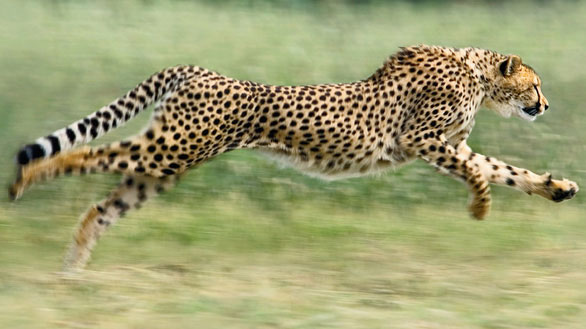Why can't humans run as fast as ... newspapers?
Humans ranked 28th on the planet's fastest-running list of species, but they could not run as fast as the Cheetah newspaper. Why?
The average speed of this leopard species is about 112 km / h, while the record speed that the "black lightning" achieved in 2009 is only 44.72km / h, or about 1/3 of Cheetah's speed.
Amazing speed mystery
According to Science ABC, the body of the Cheetah jaguar has many advantages to facilitate perfect sprints. Specifically, the body of the newspaper is relatively light to help the legs do not waste a lot of energy when moving and at the start. The slender ribs and the small head of the newspaper limit air resistance when running.

Having a lot of advantages for running fast, the Cheetah newspaper still has no competitors at speed ranges - (Photo: GETTY IMAGES).
The Cheetah leopard is also the only one among the animals that cats cannot fully claw into when running, thereby increasing their stability to the ground when traveling at high speeds.
Flexible operating tail provides balance, while the backbone system is capable of quick and easy navigation. The shoulder and neck bones are not really attached to each other, helping the legs in particular and the body in general can easily expand, thus moving the distance further.
The legs are also very special when touching the ground at the same time instead of each leg or pair, creating uniformity when moving.
In 2012, a team from Yamaguchi University in Japan discovered that Cheetah's muscular system was much more prominent than cats or dogs, creating tremendous thrust from the two limbs.
Specifically, type 1 muscle bundles which produce weak but highly durable forces are mostly located in the front legs of jaguars. In contrast, Cheetah's hind legs contain most of the type II muscle bundles that work to create extremely powerful forces but with poor stamina, only suitable for galloping.
The distribution of these two types of muscle in two pairs of jaguars is also the principle of operation of many cars today, in which the rear two wheels mainly produce the force and the front two wheels do the balance when decelerating. and navigation.
Why don't humans run faster than Cheetah?

The best performance of "black lightning" Usain Bolt is only 1/3 the speed of Cheetah - (Photo: BBC).
There are many factors that are not suitable for people to run fast. First, when evolving from the apes, the hands and feet of the developers are larger , giving people a balance, especially when standing on two legs but thereby also limiting the speed when moving.
The human eye only allows the foot to move forward but not backward, thus preventing the ability to move. The human body or head is also larger, so the air resistance is more affected.
One of the main reasons lies in the structure of muscles . Of the total human muscle, about 48% are slow contraction, 50% contraction is fast and only 2% of the muscle is very fast, whereas the number of contractions is up to 70%.
However, the ratio between the amount of slow muscle and fast muscle is not the same and depends on each person. This ratio in theory represents a person's speed and is almost impossible to change.
Of course, regular exercise can help the muscles to function more flexibly and healthily but cannot significantly increase the amount of contractions.
Therefore, almost people cannot "usurp" the Cheetah jaguar in speed races.
- Read electronic newspapers to help you live longer
- Online newspapers surpassed the paper in America
- Photograph of extremely rare Persian leopard in Russia
- All information about BRT express bus
- Apricot newspapers were bitten by the same type in the death battle
- Rats eat with newspapers
- What you don't know about BRT super fast bus systems around the world
- Interesting things about cougars
- Read newspapers directly from Facebook's News Feed
- Decoding super-fast stars in 'Ngan river'
- 8 harsh facts about fast food you ... should know
- Online newspapers achieved double-digit growth rates
 Animal 'suffering' after hibernation
Animal 'suffering' after hibernation Why do goats climb well?
Why do goats climb well? Scientists were surprised to see chimpanzees eating turtles
Scientists were surprised to see chimpanzees eating turtles Giant catfish died deadly due to drought in Thailand
Giant catfish died deadly due to drought in Thailand